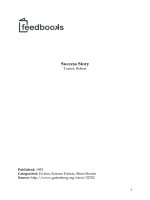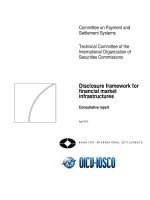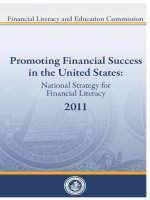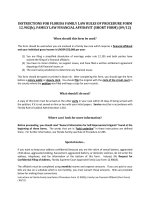Reversal Short Financial Success Strategies_12 pdf
Bạn đang xem bản rút gọn của tài liệu. Xem và tải ngay bản đầy đủ của tài liệu tại đây (356.83 KB, 23 trang )
Questions and answers 283
Chapter 11 questions
1 Coca-Cola’s earnings prospects are good, but the stock market as a whole has
been bearish and volatile lately. The market could rally, or it could retrace to
recent lows, dragging Coca-Cola along with it. The stock price is 52.67, and
the following August options are listed with 90 days until expiration:
Coca-Cola at 52.67
August options with 90 days until expiration:
Coca-
Cola
strike
45.00 47.50 50.00 52.50 55.00 57.50 60.00
Calls
4.04 2.52 1.45 0.79 0.34
Puts
0.82 1.30 2.05 2.90 4.25
(a) i) What is the cost of the August 52.50 straddle?
ii) At expiration, what is the upside break-even level?
iii) What is the downside break-even level?
iv) What is the maximum profit?
v) What is the maximum loss?
vi) What is the profit/loss if the stock closes at 57.50 at
expiration?
(b) i) What is the cost of the long August 50–55 strangle?
ii) At expiration, what is the upside break-even level?
iii) What is the downside break-even level?
iv) What is the maximum profit?
v) What is the maximum loss?
vi)
What is the profit/loss if the stock closes at 47.50 at expiration?
(c) Why is the 50 put priced higher than the 55 call?
2 In the UK, the outlook for Sainsbury during the next several months is for
continued good, but not spectacular, trading, and you expect the shares to be
stable. The implied volatility for the options is 38 per cent, down from over
50 per cent. It is November, and the January options are entering their accel-
erated time decay period. Sainsbury is trading at 537.5, and the following
options prices are listed:
Sainsbury at 537.5
January options with 70 days until expiry:
284 Questions and answers
Strike
420 460 500 550 600 650 700
Calls
34 17.5 8 3
Puts
3 8 17.5 39.5
i) What is the income from selling the January 500–600 strangle?
ii) At expiry, what is the upside break-even level?
iii) What is the downside break-even level?
iv) What is the maximum profit?
v) What is the maximum loss?
Chapter 11 answers
1 (a) i) 2.52 + 2.90 = 5.42
ii) 52.50 + 5.42 = 57.92
iii) 52.50 – 5.42 = 47.08
iv) upside unlimited; downside, value of the stock
v) 5.42
vi) [57.50 – 55] – 5.42 = –2.92 loss
(b) i) 2.05 + 1.45 = 3.50
ii) 55 + 3.50 = 58.35
iii) 50 – 3.5 = 46.5
iv) upside unlimited; downside 50 – 3.5 = 46.5
v) 3.50
vi) 5 – 3.5 = 1.5
(c) Because of the put volatility skew. This explained in Part 4.
2 i) 17.5 + 17.5 = 35
ii) 600 + 35 = 635
iii) 500 – 35 = 465
iv) 35
v) unlimited upside, 465 on the downside.
Questions and answers 285
Chapter 12 questions
1 Refer to the previous set of Sainsbury January options:
Sainsbury at 537.5
January options with 70 days until expiry
Strike
420.0 460.0 500.0 550.0 600.0 650.0 700.0
Calls
34.0 17.5 8.0 3.0
Puts
3.0 8.0 17.5 39.5
(a) i) What is the income from the short January 460–500–600–650
iron condor? This is an asymmetric spread.
ii) At expiry, what is the upside break-even level?
iii) What is the downside break-even level?
iv) What is the maximum upside loss?
v) What is the maximum downside loss?
vi) What is the maximum profit from this spread?
vii) What is the profit range?
(b) i) What is the income from the short January 460–550–650 iron
butterfly? This is also an asymmetric spread.
ii) At expiry, what is the upside break-even level?
iii) What is the downside break-even level?
iv) What is the maximum upside loss?
v) What is the maximum downside loss?
vi) What is the maximum profit?
vii) What is the profit range?
2 Given the previous set of Coca-Cola options.
Coca-Cola at 90
August options with 90 days until expiration
Strike
45.00 47.50 50.00 52.50 55.00 57.50 60.00
Calls
4.04 2.52 1.45 0.79 0.34
Puts
0.82 1.30 2.05 2.90 4.25
286 Questions and answers
(a) i) What is the cost of the long August 45–50–55–60 iron condor?
ii) At expiration, what is the upside break-even level?
iii) What is the downside break-even level?
iv) What is the maximum upside profit?
v) What is the maximum downside profit?
vi) What is the maximum loss?
(b) i) What is the cost of the long August 45–52.50–60 iron
butterfly?
ii) At expiration, what is the upside break-even level?
iii) At expiration, what is the downside break-even level?
iv) What is the maximum upside profit?
v) What is the maximum downside profit?
vi) What is the maximum loss?
Chapter 12 answers
(a) i) 17.5 + 17.5 – 8 – 8 = 19 credit
ii) 600 + 19 = 619
iii) 500 – 19 = 481
iv) [650 – 600] – 19 = 31
v) [500 – 460] – 19 = 21
vi) 19
vii) 619 – 481 = 138
(b) i) 34 + 39.5 – 8 – 8.5 = 57.5 credit
ii) 550 + 57.5 = 607.5
iii) 550 – 57.5 = 492.5
iv) [650 – 550] – 57.5 = 42.5
v) [550 – 460] – 57.5 = 32.5
vi) 57.5
vii) 607.5 – 492.5 = 115
2 (a) i) 2.05 + 1.45 – 0.82 – 0.34 = 2.34 debit
ii) 55 + 2.34 = 57.34
iii) 50 – 2.34 = 47.66
iv) [60 – 55] – 2.34 = 2.66
v) [50 – 45] – 2.34 = 2.66
vi) 2.34
Questions and answers 287
(b) i) 2.52 + 2.90 – 0.82 – 0.34 = 4.26 debit
ii) 52.50 + 4.26 = 56.76
iii) 52.50 – 4.26 = 48.24
iv) [60 – 52.50] – 4.26 = 3.24
v) [52.50 – 45] – 4.26 = 3.24
vi) 4.26
288 Questions and answers
Chaper 13 Questions
1 In the UK, the FTSE-100 index has been bullish since the end of October,
and you expect this trend to continue through the end of the year. The
December futures contract is currently at 5470. Using technical analysis, you
determine that there is resistance at a former support area between 5700 and
5800. You note the following European-style December call options:
December FTSE contract at 5470
December options with 40 days until expiry
Strike
5625.0 5675.0 5725.0 5775.0 5825.0 5875.0 5925.0 5975.0 6025.0
Calls
159.5 137.5 117.0 97.5 81.0 68.0 57.0 46.5 35.5
(a) i) What is the cost of the long 5675–5775–5875 call butterfly?
ii) At expiry, what is the maximum profit of the spread?
iii) What is the lower break-even level?
iv) What is the upper break-even level?
v) What is the profit range?
vi) What is the maximum loss?
(b) i) What is the cost of the long 5625–5725–5825–5925 call condor?
ii) At expiry, what is the maximum profit of the spread?
iii) What is the lower break-even level?
iv) What is the upper break-even level?
v) What is the profit range?
vi) What is the maximum loss?
(c) How do you account for the greater profit range of the condor?
2 Because of budget deficit problems in Western economies the stock markets
have been extremely volatile. However, bail-out packages with the IMF and
the more solvent nations have finally been agreed upon. The global stock
markets have sold off, and you expect them to range for the next two months.
DJ Eurostoxx 50 at 2831
June puts with 57 days until expiration
Strike
2700 2750 2800 2850
Puts
54.50 68.40 85.80 107.00
Questions and answers 289
(a) i) What is the price of the long June 2850–2800–2750 put
butterfly?
ii) At expiration, what is the maximum profit?
iii) What is the upper break-even level for this butterfly?
iv) What is the lower break-even level?
v) What is the profit range?
vi) What is the maximum loss?
(b) i) Suppose you prefer to leave yourself a margin of error in your
outlook. You are range bearish. What is the cost of the 2850–
2800–2700–2650 put condor?
ii) At expiration, what is the maximum profit?
iii) What is the upper break-even level?
iv) What is the lower break-even level?
v) What is the profit range?
vi) What is the maximum loss?
(c) Compare the advantages and disadvantages of the put butterfly to
the put condor.
Chapter 13 answers
1 (a) i) 137.5 + 68 – [2 × 97.5] = 10.5
ii) [5775 – 5675] – 105 = 89.5
iii) 5675 + 10.5 = 5685.5
iv) 5875 – 10.5 = 5864.5
v) 5864.5 – 5685.5 = 179 points
vi) 10.5 = £105
(b) i) 159.5 + 57 – 117 – 81 = 18.5
ii) [5725 – 5625] – 18.5 = 81.5
iii) 5625 + 18.5 = 5643.5
iv) 5925 – 18.5 = 5906.5
v) 5906.5 – 5643.5 = 263 points
vi) 18.5 = £185
(c) The condor has a gross profit range that is 100 points greater. The
8p extra cost reduces eight points of profit from both the lower
and upper break-even levels. The net profit range of the condor is
therefore 84p greater.
2 (a) i) 107 + 68.40 – (2 × 85.80) = 3.8
ii) (2850 – 2800) – 3.8 = 46.2
290 Questions and answers
iii) 2850 – 3.8 = 2846.2
iv) 2750 + 3.8 = 2753.8
v) 2846.2 – 2753.8 = 92.4 points
vi) 3.8
(b) i) 107 + 54.5 – 85.8 – 68.4 = 7.3
ii) (2850 – 2800) = 42.7
iii) 2850 – 7.3 = 2842.7
iv) 2650 + 7.3 = 2657.3
v) 2842.7 – 2657.3 = 185.4 points
vi) 7.3
(c) The condor has a gross profit range that is 185.4 – 92.4 = 93 points
greater at an additional cost of 3.5.
Questions and answers 291
Chapter 14 questions
1 Your shares in Intel have performed well in the past, but now, with the pos-
sibility of a global recession, Intel’s orders are down, and the stock is in a
trading range. You are looking to supplement your dividend by writing one
call on each 100 shares that you own. You realise that if the stock rallies
above the call strike price, it will be called away from you. Intel is currently
trading at 21.42, and the July 24 calls, with 46 days until expiration, are
trading at 0.21. They are 12 per cent out-of-the-money.
(a) What is the maximum profit from writing one July 24 call?
(b) What happens if at expiration the stock closes above 24?
(c) What is the break-even level?
(d) What is your percentage return over the next 46 days with your
stock valued at 21.42?
2 Sainsbury’s range this past year is no less than 370 to 588.5. You have held
onto your shares, riding the market turbulence. Because supermarkets are cur-
rently cutting prices, you forsee reduced profit margins for the near term.
Sainsbury is currently trading at 537.5. With 70 days until expiration, the
January 550 calls are trading at 34, and the January 600 calls are trading at
17.5. You would like to sell one of these as a covered write on 1,000 shares
that you own.
(a) i) What is the maximum profit from writing one January 550
call?
ii) What happens if at expiry the shares closes above 550?
iii) What is the break-even level?
iv) What is your percentage return over the next 70 days with
your shares valued at 537.5?
(b) i) What is the maximum profit from writing one January 600
call?
ii) What happens if at expiry the shares closes above 600?
iii) What is the break-even level?
iv) What is your percentage return over the next 70 days with
your shares valued at 537.5?
292 Questions and answers
3 It is late November, and IBM is currently trading at 159.75. You expect IBM
to remain at approximately 160 for the next month. You note the following
prices for 160 calls.
November 160 calls, with one day until expiration: 0.69
December 160 calls, with 29 days until expiration: 5.13
January 160 calls, with 64 days until expiration: 7.5
(a) What is the cost of the December–January 160 call calendar?
(b) Barring a special dividend or takeover within the next 29 days,
what is the maximum loss of your calendar spread?
(c) i) Although there are 28 days between November and December
expirations, and 35 days between December and January
expirations, you would like to estimate the profit potential
of the December–January spread. What is your estimate for
the value of this spread with IBM at 160 and one day until
December expiration?
ii) Would you expect the December–January spread to be worth
more or less than the November–December spread?
Chapter 14 answers
1 (a) [24 – 21.42] + 0.21 = 2.79
(b) Your stock will be called away, or sold, but you will still have your
maximum profit.
(c) 21.42 – 0.21 = 21.21
(d) 0.21/21.42 = 1%
2 (a) i) [550 – 537.5] + 34 = 46.5
ii) Your shares will be called away, or sold, but you will still have
your maximum profit.
iii) 537.5 – 34 = 503.5
iv) 34/537.5 = 6.33%
(b) i) [600 – 537.5] + 17.5 = 80
ii) Your shares will be called away, or sold, but you will still have
your maximum profit.
iii) 537.5 – 17.5 = 520
iv) 17.5/537.5 = 3.26%
3 (a) 7.5 – 5.13 = 2.37
Questions and answers 293
(b) 2.37
(c) i) Estimate would equal the November–December spread’s
value, 5.13 – 0.69 = 4.44.
ii) More, because the long January call will have more days until
expiration than the long December call. This doesn’t imply
greater profit potential, however, because the November–
December spread would have cost less to begin with. This
analysis assumes that the three implied volatilities are equal
and will remain constant.
294 Questions and answers
Chapter 15 questions
1 Coca-Cola is trading at 52.67 For the September 60 calls with 90 days until
expiration, note whether time passing causes the following Greeks to increase,
decrease or remain unchanged.
(a) delta
(b) gamma
(c) vega
(d) theta
2 Answer the above questions for the September 52.50 calls.
(a) delta
(b) gamma
(c) vega
(d) theta
3 (a) If the manager of your pension fund wants to hedge a portfolio
of stocks and Treasury Bills against a possible interest rate increase
during the next two weeks, which options position or positions
might he employ?
(b) In terms of the Greeks, compare the advantages and disadvantages
that he might consider by employing out-of-, or at-the-money
options.
i) delta
ii) gamma
iii) vega
iv) theta
(c) Suppose he considers an at-the-money option. In terms of the
Greeks, compare the advantages of employing a 30-day option to
a 60-day option.
i) delta
ii) gamma
iii) vega
iv) theta
(d) Now suppose he considers an out-of-the-money option. In terms
of the Greeks, compare the advantages of employing a 30-day
option to a 60-day option, each at the same strike.
i) delta
ii) gamma
iii) vega
iv) theta
Questions and answers 295
(e) Getting settlements from exchange websites, choose an option or
two from the major stock indexes: DJ Eurostoxx 50, SPDRS or SPX,
FTSE-100, CAC or DAX, etc. Follow the options for the next two
weeks.
4 The December FTSE futures contract is currently at 5530 and you are long
one the December 5575 call which is currently trading at 190. A rumour cir-
culates that a certain tabloid baron has dropped his opposition to European
monetary union because he has formed a partnership with an Italian media
mogul, and the December futures contract rallies to 5620. You know that
your call position has made a profit, and while awaiting a price quote (and
a possible change in the tabloid’s editorial policy), you decide to evaluate the
effect of the market move on your call’s Greeks. How will they be affected by
the change in the December futures contract?
(a) delta
(b) gamma
(c) vega
(d) theta
5 Coca-Cola is currently trading at 52.67. The January options have 60 days
until expiration and the December options have 30 days until expiration. Is
each of the following statements true or false?
(a) If the implied volatility increases, then the delta and theta of the
January 47.50 put will also increase.
(b) If the implied increases, then the gamma of the January 57.50 call
will increase, and the vega will decrease.
(c) If the implied decreases, then the vega of the December 52.50 call
will decrease.
(d) If the implied decreases, then the gamma and delta of the January
47.50 call will increase.
6 Under what circumstances can an increase in the implied cause an increase
in an out-of-the-money option’s gamma?
7 Suppose the S&P 500 index is at 1030, and you are long a number of 975
puts. The chairman of the US Federal Reserve bank, who is liked by the
financial markets, announces that he is to retire when his term expires. What
may happen to the implied volatility of your put options?
296 Questions and answers
Chapter 15 answers
1 (a) decrease
(b) increase
(c) decrease
(d) increase
2 (a) practically unchanged
(b) increase
(c) decrease
(d) increase
3 (a) Purchase puts on a stock index and/or eurodollars.
(b) i) ATM puts provide more coverage per option.
ii) ATM puts respond more to market movement.
iii) ATM puts are more sensitive to an increase or decrease in the
implied.
iv) OTM puts cost less in time decay.
(c) i) No difference.
ii) Near-term has greater gamma, it responds more to market
movement.
iii) Not-so-near is more sensitive to change in the implied.
iv) Near-term costs more in daily time decay.
(d) i) 60-day has larger delta, therefore more coverage per option.
ii) 30-day has greater gamma.
iii) 60-day is more sensitive to change in the implied.
iv) 30-day costs more in daily time decay.
4 (a) Increased.
(b) Practically unchanged because the call is now as equally far in-the-
money as it was formerly out-of-the money.
(c) Unchanged, for the above reason.
(d) Unchanged, for the above reason.
5 (a) True.
(b) False, the gamma will decrease but the vega will increase.
(c) False, it will remain practically unchanged.
(d) True.
Questions and answers 297
6 If the implied is increasing from a very low level then the gammas of the far
out-of-the-money options will increase.
7 If his retirement is unexpected, then the implied may increase due to uncer-
tainty; if his retirement is expected, then the implied will most likely remain
unchanged.
298 Questions and answers
Chapter 21 questions
1 Given the following set of FTSE December European-style options, calculate
the price of the missing call or put using the put–call parity formulas.
FTSE December futures contract at 5470
Strike
5325.0 5475.0 5525.0 5725.0
December calls
306.5 ? ? 97.5
December puts
? 217.0 238.5 ?
(a) December 5325 put
(b) December 5475 call
(c) December 5525 call
(d) December 5725 put
2 Given the following May options on Marks and Spencer, determine the price
of the synthetic futures contract and the prices of the missing options. Bear
in mind that these are settlements and that there can be small discrepancies
between their values and the synthetic that they equal.
M&S at 350.60
May options with 75 days until expiry
Strike
330.00 340.00 350.00 360.00 370.00
December calls
28.50 ? 15.75 11.00 ?
December puts
? 10.25 14.75 ?
(a) May synthetic futures contract
(b) May put
(c) May 340 call
(d) May 360 put
(e) May 370 call
Questions and answers 299
Chapter 21 answers
1 (a) 306.5 – 5470 + 5325 = 161.5
(b) 5470 – 5475 + 217 = 212
(c) 5470 – 5525 + 238.5 = 183.5
(d) 97.5 – 5470 + 5725 = 352.5
2 (a) 15.75 – 14.75 + 350 = 351
(b) 28.50 – 351 + 330 = 7.50
(c) 351 – 340 + 10.00 = 21.00
(d) 11.00 – 351 + 360 = 20.00
(e) 351 – 370 + 26 = 7.00
300 Questions and answers
Chapter 22 questions
1 Suppose the current Bank of England interest rate is 3 per cent.
(a) With 37 days until expiry what is the price of a December 1,000
point box in the FTSE-100 European-style options? (Hint: the box
trades at a discount.)
(b) Suppose you want to borrow or lend money for the next 37 days
at the above rate in the FTSE options market. What strategy,
bought or sold, would enable you to trade money at approxi-
mately 3 per cent?
(c) The December FTSE futures contract is trading at 5470, and three
legs of the 4975–5975 box are trading as indicated below. What is
the price of the fourth leg?
FTSE December futures at 5470
Strike
4975.0 5975
December calls
572.5 35.5
December puts
81.0 ?
2 The purpose of the following questions is to help you understand how conver-
sions and reversals form the basis of bid–ask spreads, or markets, for options.
M&S at 350.60
May options, 75 days until expiry
Bank of England rate at 0.50 per cent
Strike
350.00
January calls theoretical value
15.75
January puts theoretical value
14.75
(a) What is the value of the May synthetic future, and why is it so
valued?
(b) To be realistic, there is probably a bid–ask market for Marks and
Spencer of 350–351 and the spread is certain to increase during
volatile markets. In order to price the May 350 conversion, the
market assumes that the shares are bought at 351. At what price
must the call and put be traded in order to break even, or make a
small profit on the cost of carry on the shares?
Questions and answers 301
(c) Now determine the market price of May 350 reversal. Here the
shares must be sold at 350. At what prices must the call and put be
traded in order to break even, or make a small profit on the cash
income from the shares?
(d) If the prices in the options markets correspond to the current Bank
of England rate, what would be the minumum bid–ask markets for
the May 350 calls and puts?
Chapter 22 answers
1 (a) 1000 × 0.03 × 37/360 = 3 points discount from 1,000. The box is
priced at 1,000 – 3 = 997. The market for the box is probably 995
– 999.
(b) Purchase boxes in the FTSE to lend, sell boxes to borrow.
(c) 997 = (572.5 – 81) – (35.5 + ?)
? = 997 – 572.5 + 81 + 35.5
(d) ? = 541
2 (a) 350 + 15.75 – 14.75 = 351. The £0.40 price above the shock is due
to the cost of carry on the shock for 75 days: 350.60 + (350.60 ×
0.005 ×
75
/
365
) = 0.36, traded at 0.40.
(b) The synthetic must be sold at £0.40 over the ask price of the stock
in order to recoup the cost of carry. Bearing in mind that the
options contract trades in multiples of 0.25, the synthetic must
be sold at 351.50. This is possible if the call is sold at 16.00, and
14.50 is paid for the put.
(c) If the return on a sale of the stock is 0.50 per cent, then no more
than £0.40 must be paid for the synthetic over the bid price of the
stock. Bearing in mind that the options contract trades in mul-
tiples of 0.25, the synthetic must be traded at 350.25. Therefore
15.25 will be paid for the call, while the put will be sold at 15.00.
(d) Call market is 15.25 – 16.00
Put market is 14.50 – 15.00
Glossary
The following glossary is best used as a quick reminder of basic options
definitions. Alternatively, it may be used as a source of jargon for small
talk at wine bars. (Make sure you’re overheard.) It is no substitute for
proper learning.
American style An American-style option can be exercised at any date
during the life of the option’s contract.
Asymmetric spread A spread whose strikes are not equidistant.
At-the-money (ATM) Calls and puts closest to the underlying.
Bear call spread Short call spread.
Bear put spread Long put spread.
Box A long box is a long synthetic plus a short synthetic at a higher strike.
A short box has the opposite long/short position.
Broken spread An asymmetric spread.
Bull call spread Long call spread.
Bull put spread Short put spread.
Butterfly A long call butterfly is a long one by two call spread plus a long
call at a third, higher strike. All strikes are equidistant. A long put butter-
fly is a long one by two put spread plus a long put at a third, lower strike.
Again, all strikes are equidistant. For shorts of these spreads, reverse the
long/short positions.
Calendar spread A long calendar spread is a long option plus a short
option that is closer to expiration. Both options have the same strike.
304 Glossary
Call A call option is the right to buy the underlying asset at a specified
price for a specified time period. The call buyer has the right, but not the
obligation, to buy the underlying. The call seller has the obligation to sell
the underlying at the call buyer’s discretion.
Call spread A long call spread is a long call plus a short call at a higher
strike. A short call spread is the opposite.
Christmas tree See Ladder.
Combo A long out-of-the-money call plus a short out-of-the-money put,
or vice versa. This is also known as the cylinder. The short call, long put
version is also known as the fence. Occasionally this term applies to the
synthetic underlying.
Condor A long call condor is a long call spread plus a short call spread
at higher strikes. All strikes are equidistant. A long put condor is a long
put spread plus a short put spread at lower strikes. Again, all strikes are
equidistant.
Conversion A long underlying plus a short synthetic.
Covered write A long underlying plus a short out-of-the-money call. This
is also know as the buy-write.
Cylinder See Combo.
Delta The rate of change of an option with respect to a change in the
underlying.
Delta neutral Any combination of options and an underlying position
whose delta sum is practically zero.
Delta/price ratio The percent that an option’s value changes with respect
to a change in the underlying.
Diagonal spread A long diagonal is a long option plus a short option that
is closer to expiration and further out-of-the-money.
European style A European-style option can only be exercised at expiration.
Extrinsic value See Time premium.
Fence See Combo.
Future A contract to buy or sell a physical asset at a specified price at a
specified future date. This asset can be a commodity, bond or stock. In the
case of a stock index, the contract is for a cash value of all the stocks that
comprise the index.
Glossary 305
Gamma The rate of change of the delta with respect to a change in the
underlying.
Hybrid spread A spread combination that is not one of the standard
spreads.
In-the-money (ITM) Apart from at-the-money options, calls below the
underlying and puts above the underlying.
Intrinsic value The amount that an option is in the money, or the parity
component of an in-the-money option.
Iron butterfly A long iron butterfly is a long straddle plus a short strangle
with all strikes equidistant. A short iron butterfly has the opposite long/
short position.
Iron condor A long iron condor is a long strangle plus a short strangle that
is further out of the money. A short iron condor has the opposite long/
short position.
Ladder A long call ladder is a long call spread plus a short call at a third,
higher strike. Usually all strikes are equidistant. A long put ladder is a long
put spread plus a short put at a third, lower strike. Again, all strikes are
usually equidistant. Also known as the Christmas tree.
Leverage The right or obligation to trade the full value of the underlying
by trading only the value of the option.
Long To be long is to own. A long futures contract owns a cash or physical
asset when the contract expires. A long options contract owns the right to
buy, for a call, or the right to sell, for a put.
Long deltas Any combination of long calls, short puts and long underlying.
Margin Cash or liquid security deposited by holders of futures or options
contracts.
Multiplier Part of a contract specification: the cash amount by which a
futures or options value is multiplied.
Naked A short option not spread with a long option or underlying.
One by two A long one by two call spread is a long call plus two short
calls at a higher strike. A long one by two put spread is a long put plus two
short puts at a lower strike.
Out-of-the-money (OTM) Apart from at-the-money options, calls above the
underlying and puts below the underlying.









